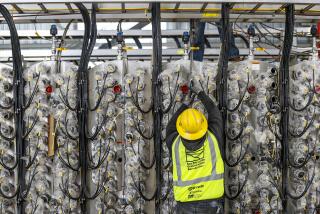EPA takes over cleanup
Citing repeated delays and violations of environmental law, federal regulators Tuesday sent their own work crews to finish removing oil and contaminated water released into a Santa Maria creek by Greka Energy Corp.
About 200 barrels of crude oil and toxic water leaked out of a corroded pipe at Greka’s Bell lease site Jan. 29, migrating to a tributary of Sisquoc Creek, officials with the U.S. Environmental Protection Agency said.
Greka and its contractors failed to clean the site in a timely manner, prompting the federal government to step in, said Robert Wise, an emergency response coordinator for the EPA.
“We still have oil in the creek, and the creek is still flowing. There is a lot of wildlife in that area and a lot of cattle,” Wise said. “We want to make sure it gets cleaned up properly so there is no long-term contamination.”
In a statement, Greka officials said they were in the process of hiring a contractor to perform the cleanup when the EPA rejected the plan and took control of the site. When representatives of the EPA and Greka inspected the affected creek bed two weeks ago, there appeared to be no problem, Greka officials said.
“It has always been Greka’s plan to clean up the Bell lease site as efficiently and quickly as practical,” the company said in a statement.
Tuesday’s action is the latest slap at the Santa Maria-based oil company by federal, state and local authorities. Santa Barbara County authorities have issued stop-work orders at several of Greka’s 77 facilities and, during a three-hour hearing in January, grilled company officials about repeated oil spills at its operations.
The state Fish and Game Department and the EPA are investigating alleged violations of environmental and safety laws. At the January hearing, county officials said the Fire Department has responded at least 400 times to oil spills and gas leaks at Greka since the energy company opened for business in 1999.
Those spills have sent more than 450,000 gallons of thick crude and polluted waters into creeks and soil, officials said. EPA regulators are supervising cleanups of spills or leaks at three Greka sites since Jan. 1, Wise said.
“We’ve been pretty much out there continuously since Jan. 5,” Wise said, referring to a command post that the EPA had set up on one of Greka’s Santa Maria leases. “I’ve never been in a situation where we are on site for one spill, and then there’s another and another and another.”
On Tuesday, Greka officials accused the EPA of inaccurately depicting the chain of events leading to regulators taking over the Bell lease site cleanup. Greka said that it delivered work plans to the EPA in a timely manner and that it notified the agency last week that it would need more time to prepare a detailed plan for removing sediment from a soiled pond at the site.
Instead, the EPA moved ahead with its own cleanup, the statement said.
Greka bought dozens of aging oil sites and equipment in northern Santa Barbara County in the late 1990s, pumping thick crude for asphalt. The company has offices in New York, Santa Maria and Beijing, and is a subsidiary of Green Dragon, a China-based energy company owned by Randeep Grewal.
Greka has taken the offensive in recent months, saying it has been the victim of sabotage by competitors and accusing regulators of singling it out for punishment.
Its attorneys have threatened to bring a $100-million lawsuit against Santa Barbara County if it is not permitted to reopen production after site cleanups are completed.
In late January, Greka announced a new “green” initiative and said it would pour millions of dollars into upgrading its old pipelines, leaky tanks and faulty pumps. EPA’s Wise said much of Greka’s problems can be traced to outdated equipment and poor maintenance. The firm faces fines of up to $32,500 per day for each violation. Greka also will be billed for the cost of the EPA cleanup that started Tuesday.
“They keep telling us they’ve spent tens of millions of dollars upgrading their equipment,” Wise said. “But we haven’t seen any evidence of it.”
--
catherine.saillant@latimes.com
More to Read
Sign up for Essential California
The most important California stories and recommendations in your inbox every morning.
You may occasionally receive promotional content from the Los Angeles Times.











